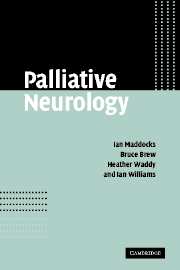Book contents
- Frontmatter
- Contents
- Foreword
- Note on drugs and abbreviations
- Section I Palliative Management
- Section II Major discomforts in advanced neurological illness
- Section III Major neurological conditions requiring palliation
- 1 Cerebrovascular disease: stroke
- 2 Demyelinating disease
- 3 Parkinson's disease and related disorders
- 4 Dementia
- 5 Amyotrophic lateral sclerosis (motor neurone disease)
- 6 Incurable Infections of the nervous system
- 7 Muscular dystrophy
- 8 Neuropathies
- 9 Huntington's disease
- 10 Cerebral neoplasms
- 11 Sequelae of traumatic brain injury
- Section IV Ethical issues
- Section V Appendices
- Index
2 - Demyelinating disease
from Section III - Major neurological conditions requiring palliation
Published online by Cambridge University Press: 08 January 2010
- Frontmatter
- Contents
- Foreword
- Note on drugs and abbreviations
- Section I Palliative Management
- Section II Major discomforts in advanced neurological illness
- Section III Major neurological conditions requiring palliation
- 1 Cerebrovascular disease: stroke
- 2 Demyelinating disease
- 3 Parkinson's disease and related disorders
- 4 Dementia
- 5 Amyotrophic lateral sclerosis (motor neurone disease)
- 6 Incurable Infections of the nervous system
- 7 Muscular dystrophy
- 8 Neuropathies
- 9 Huntington's disease
- 10 Cerebral neoplasms
- 11 Sequelae of traumatic brain injury
- Section IV Ethical issues
- Section V Appendices
- Index
Summary
Multiple sclerosis (MS) is the most common condition in this group of diseases. It is characterized by two distinct pathological processes: the development of inflammatory plaques throughout the central nervous system and progressive axonal degeneration. It is usually regarded as an autoimmune disorder, stemming from a combination of unknown environmental factors and genetic predisposition.
It is a disease that affects mainly younger adults; it has a variable course, often there are periods of relapse and improvement, but overall a progressive deterioration, which may occasionally be rapid, but more usually is prolonged, extending even for decades (Figure 111.2.1). The prolonged natural history of the disease means that it is rare for one physician to follow an affected person throughout its entire course.
Not all cases will follow a steadily progressive intermittent course. Three main forms are recognized:
relapsing and remitting MS (illustrated);
primary progressive MS in which remissions do not occur;
secondary progressive disease where progression occurs late in the disease.
Diagnosis and prognosis
Magnetic resonance imaging (MRI), along with cerebrospinal fluid (CSF) analysis, has made it more possible to be definite about the diagnosis in the early stages. As initially the long-term outlook cannot be predicted with any certainty, the way in which the disease and its potential discomforts are discussed at the time of diagnosis assumes major importance. There are some agreed indicators that may be helpful in guiding predictions of a favourable or unfavourable prognosis.
- Type
- Chapter
- Information
- Palliative Neurology , pp. 132 - 141Publisher: Cambridge University PressPrint publication year: 2005



